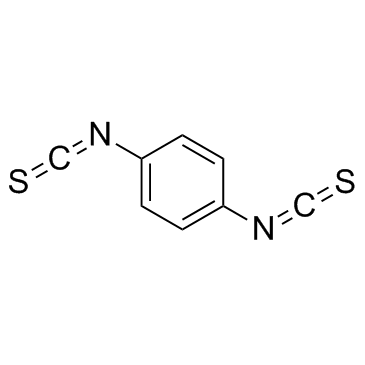p-Phenylene diisothiocyanate

p-Phenylene diisothiocyanate structure
|
Common Name | p-Phenylene diisothiocyanate | ||
|---|---|---|---|---|
| CAS Number | 4044-65-9 | Molecular Weight | 192.26100 | |
| Density | 1.2g/cm3 | Boiling Point | 339.4ºC at 760 mmHg | |
| Molecular Formula | C8H4N2S2 | Melting Point | 129-131 °C(lit.) | |
| MSDS | Chinese USA | Flash Point | 167.2ºC | |
| Symbol |


GHS06, GHS08 |
Signal Word | Danger | |
|
Label-free impedimetric immunosensor for ultrasensitive detection of cancer marker Murine double minute 2 in brain tissue.
Biosens. Bioelectron. 39(1) , 220-5, (2013) The detection of cancer biomarkers is as important tool for the diagnosis and prognosis of cancer such as brain cancer. Murine double minute 2 (MDM2) has been widely studied as prognostic marker for brain tumor. Here we describe development of a new sensitive... |
|
|
Optimizing the immobilization of single-stranded DNA onto glass beads.
J. Biochem. Biophys. Methods 47(3) , 221-31, (2001) The attachment of single-stranded DNA to a solid support has many biotechnology and molecular biology applications. This paper compares different immobilization chemistries to covalently link single-stranded DNA (20 base pairs), oligo(1), onto glass beads via... |
|
|
Barcoded nucleotides.
Angew. Chem. Int. Ed. Engl. 51(1) , 254-7, (2012)
|
|
|
Dendrimer-activated solid supports for nucleic acid and protein microarrays.
ChemBioChem. 2(9) , 686-94, (2001) The generation of chemically activated glass surfaces is of increasing interest for the production of microarrays containing DNA, proteins, and low-molecular-weight components. We here report on a novel surface chemistry for highly efficient activation of gla... |
|
|
Subunit associations of (Na+ + K+)-dependent adenosine triphosphatase. Chemical cross-linking studies.
J. Biol. Chem. 258(16) , 9878-85, (1983) Cross-linking reactions of the alpha- and beta-subunits of the purified membrane-bound enzyme with several reagents were studied. In the presence of 1,5-difluoro-2,4-dinitrobenzene, formation of a cross-linked alpha, beta-dimer was affected specifically by K+... |
|
|
Solid-phase sequence analysis of proteins electroblotted or spotted onto polyvinylidene difluoride membranes.
Anal. Biochem. 187(1) , 10-9, (1990) Electroblotted proteins noncovalently bound to polyvinylidene difluoride (PVDF) membranes are typically sequenced using adsorptive sequencer protocols (gas-phase or pulsed-liquid) that do not require a covalent linkage between protein and surface. We have dev... |
|
|
Experimental study of the pathogenesis of infantile obstructive cholangiopathy and its clinical evaluation.
J. Pediatr. Surg. 18(2) , 131-5, (1983) 1,4-phenylenediisothiocyanate was given to five groups of rats of different developmental stages (97 in all), and the changes in the hepatobiliary system were compared histopathologically. Three groups of rats given the drug after birth showed dilatation of t... |
|
|
Different strategies of covalent attachment of oligonucleotide probe onto glass beads and the hybridization properties.
Appl. Biochem. Biotechnol. 152(1) , 54-65, (2009) The glass bead is a new biochip support material for immobilization biomolecules, due to its independence and convenient rearrangement. In order to optimize the immobilization efficiency of oligonucleotides onto glass beads and obtain the highest hybridizatio... |
|
|
Experimental model of infantile obstructive cholangiopathy using 1,4-phenylenediisothiocyanate.
Jpn. J. Surg. 11(5) , 372-6, (1981) Inflammatory processes on the hepato-biliary system may play an important role in the pathogenesis of infantile obstructive cholangiopathy (including biliary atresia, neonatal hepatitis and bile duct dilatation). A model of the disease was produced in rats us... |
|
|
Suppressive effect of 1,4-phenylene diisothiocyanate on N-butyl-N-(4-hydroxybutyl)nitrosamine-induced urinary bladder carcinogenesis in male ICR mice.
Int. J. Cancer 117(4) , 524-30, (2005) The modifying effects of dietary administration of 1,4-phenylene diisothiocyanate (DITC) on N-butyl-N-(4-hydroxybutyl) nitrosamine (BBN)-induced urinary bladder carcinogenesis during the initiation and post-initiation phases were examined in male ICR mice. Fi... |